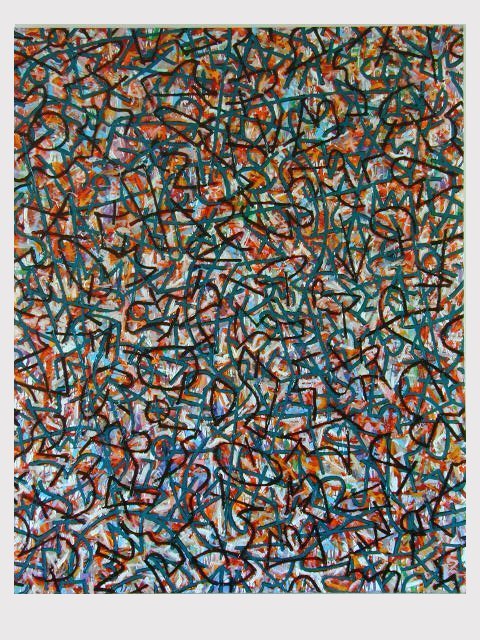|
"Writing of Light" Paintings, 9
Site takes 15 seconds to load.
In this painting, I went back to investigating how firmness can be established through movement. There is a return to the immense hardness of surface, and the razor-like power of the edge. Once again, the edge is fully integrated with, and supports, the hard surface. Let us now consider the main issue in these paintings. The question which had concerned me was this: How is it possible to create an abstract expressionist work in which the canvas marks, the canvas plane, and the canvas edge are completely and comprehensively integrated. Pollack does not solve this problem because he usually completed the painting process on a large canvas, before cutting it down by a particular choice of frame as window. The problem with that method is that the edge of the canvas is not in existence while the marks are being created, and therefore the marks are not produced in relation to the edge. In a Pollack, therefore, integration with the edge of the canvas hardly exists. It is a mere afterthought. This in turns causes a second terrible problem: It is almost impossible to have a sense of surface without a sense of edge. A surface is visually like a tense drum-skin that is stretched between a hard unobliging perimeter. Therefore, since edge is missing from a Pollack, while it is being created, so is surface. The final painting therefore only has a weak sense of edge and surface. Most importantly, there is no real integration of the three fundamental elements: the canvas marks, surface and edge. I believe that abstract expressionism must grow and develop in this critical direction in order to achieve a greater visual power. We cannot stop at the level set by the previous abstract expressionists. They were only a beginning. We must gain the formidable tense power that occurs only in a work of immense integration such as the Sistine Chapel. I had asked myself, at the beginning of this series: How is it possible to create a Sistine Chapel of integration, in abstract expressionism? The answer I achieved was this: The mark must always relate horizontally to the surface in which it is embedded, such that the surface is not a gap between marks but a solid impenetrable immovable hardness. The mark must react to the edge via that hard surface. This pulls all three together in a frozen suffocating compactness that is the totalized integration. I knew what the canvas must be before I created it because, it was exactly the religious experience that I was having: For in the religious experience, the state of totalized integration forces everything to be substance, i.e., there are no gaps, no space. Even the air becomes stone. All is declared. The canvas, like the very air, becomes assertion.

Email address: MLeyton@msn.com
|